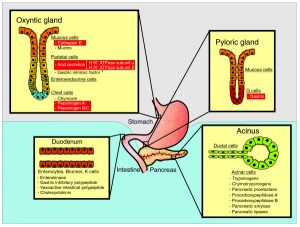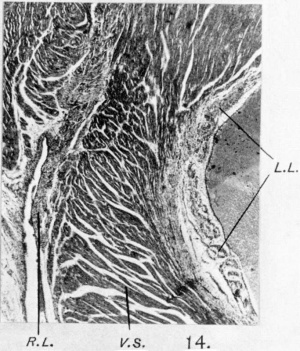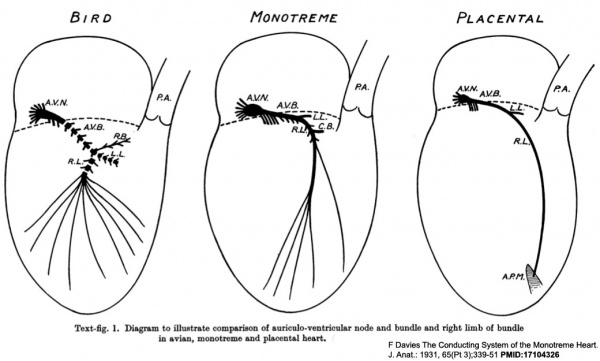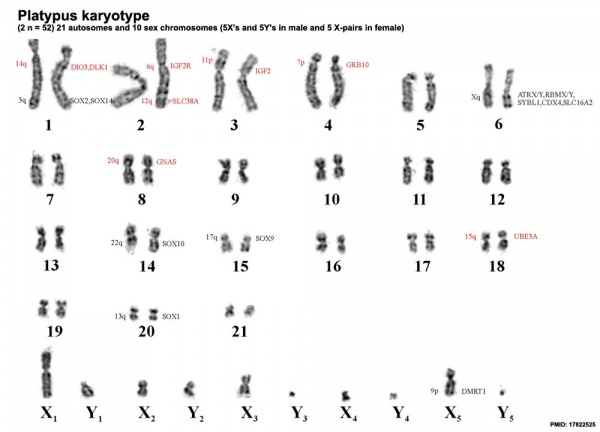Platypus Development
| Embryology - 26 Apr 2024 |
|---|
| Google Translate - select your language from the list shown below (this will open a new external page) |
|
العربية | català | 中文 | 中國傳統的 | français | Deutsche | עִברִית | हिंदी | bahasa Indonesia | italiano | 日本語 | 한국어 | မြန်မာ | Pilipino | Polskie | português | ਪੰਜਾਬੀ ਦੇ | Română | русский | Español | Swahili | Svensk | ไทย | Türkçe | اردو | ייִדיש | Tiếng Việt These external translations are automated and may not be accurate. (More? About Translations) |
Introduction
The platypus (Ornithorhynchus anatinus) also called the "duck-billed platypus" together with the 2 echidna groups (short-beaked and long-beaked) are the only 3 surviving genera of the order Monotremata.
The platypus is a unique egg-laying mammal and is not a common animal model of mammalian embryonic development. It lives in freshwater stream systems and is also the only known mammal that produces venom.
The platypus genome has also been recently sequenced.[1][2]
Why platypus? Greek Platus = flat or broad, and pous = foot.
| Australian Animal: echidna | kangaroo | koala | platypus | possum | Category:Echidna | Category:Kangaroo | Category:Koala | Category:Platypus | Category:Possum | Category:Marsupial | Category:Monotreme | Development Timetable | K12 | |||||
|
| ||||
| Animal Development: axolotl | bat | cat | chicken | cow | dog | dolphin | echidna | fly | frog | goat | grasshopper | guinea pig | hamster | horse | kangaroo | koala | lizard | medaka | mouse | opossum | pig | platypus | rabbit | rat | salamander | sea squirt | sea urchin | sheep | worm | zebrafish | life cycles | development timetable | development models | K12 |
Some Recent Findings
|
| More recent papers |
|---|
|
This table allows an automated computer search of the external PubMed database using the listed "Search term" text link.
More? References | Discussion Page | Journal Searches | 2019 References | 2020 References Search term: Platypus Development | Platypus Embryology |
| Older papers |
|---|
| These papers originally appeared in the Some Recent Findings table, but as that list grew in length have now been shuffled down to this collapsible table.
See also the Discussion Page for other references listed by year and References on this current page.
|
Taxon
Ornithorhynchus anatinus Lineage( full ) cellular organisms; Eukaryota; Fungi/Metazoa group; Metazoa; Eumetazoa; Bilateria; Coelomata; Deuterostomia; Chordata; Craniata; Vertebrata; Gnathostomata; Teleostomi; Euteleostomi; Sarcopterygii; Tetrapoda; Amniota; Mammalia; Prototheria; Monotremata; Ornithorhynchidae; Ornithorhynchus
Development Overview
Platypus mate in July to October, eggs are laid about one month later, eggs hatch and young suckle from their mother, emerging from the burrow in late January to early March.
Gestation is about 2-4 weeks (not exactly known) female lays lays usually 2 (sometimes 3) soft-shelled eggs.
Egg Development after laying, incubation approximately 6 - 10 days.
intrauterine has a major axis (approximately 17mm) and contains neurula-stage (19-20 somite) embryo with prominent trigeminal ganglion (CN 5) primordia. The embryo at this stage is in a period of rapid modelling of the major early organ primordia of the nervous system, cardiovascular system, excretory system, and somite-derived components of the body wall.
after laying five primary brain vesicles, cranial ganglia (CN5, CN7, CN8, CN9, CN10, CN11 and CN12). Alimentary system has an expanded stomach, pancreatic primordia and a gall bladder.
somitogenesis faster than in humans
Just Before Hatching- upturned snout (contains an oscaruncle and a sharp recurved median egg tooth, for shell removal). Forelimbs (pronated with separate digits with claw primordia).
Hatching- forelimbs with clawed digits and hindlimbs are still paddles with digital rays. A prominent yolk-sac navel is present.
Post-Hatching- (external features from day 0 to 6 months old) development of bill and webbing of the forefeet. Many features show similarities to marsupials (though different in both timing and morphology). (Note- exact age of the specimens relies on ages given to specimens at time of collection)
Young- feed on milk from mother and live in a river burrow for 3 - 4 months.
Differences between Platypus and Human- platypus rate of somitogenesis faster and size of early platypus embryonal area is larger, extra-embryonic membranes have unique morphology and function.
(Data/text above modified from (Hughes Hughes RL and Hall LS, 1998; Manger Manger PR, Hall LS, Pettigrew JD, 1998 and other sources)
Gastrointestinal Tract
| A study has identified differences in the gastrointestinal tract digestive enzymes secreted.[8]
Note that in humans parietal cells produce gastric intrinsic factor, but this is produced in the pancreas of monotremes and other mammals. |
Cardiovascular
Heart conduction system species comparison: Bird, Monotreme and Placental[9]
Genome
The platypus karyotype (2 n = 52) consists of 21 autosomes and 10 sex chromosomes (5X's and 5Y's in male and 5 X-pairs in female).[10]
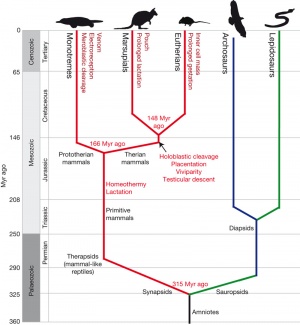
The platypus mitochondrial genome was sequenced in 1994.[11]
The nuclear genome first draft sequence was released in 2008.[2]
- "This monotreme exhibits a fascinating combination of reptilian and mammalian characters. For example, platypuses have a coat of fur adapted to an aquatic lifestyle; platypus females lactate, yet lay eggs; and males are equipped with venom similar to that of reptiles. Analysis of the first monotreme genome aligned these features with genetic innovations. We find that reptile and platypus venom proteins have been co-opted independently from the same gene families; milk protein genes are conserved despite platypuses laying eggs; and immune gene family expansions are directly related to platypus biology."
Genetic Divergence
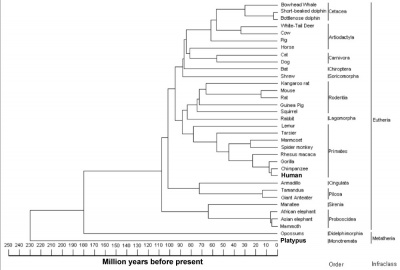
|
This graph shows the phylogeny and divergence timescales of mammalian species using the dentin phosphoprotein (DPP) gene sequence comparison.[12]
Note the early timescale divergence of the platypus species relative to the other mammalian species. |
Sex Chromosomes
The total diploid number of chromosomes is n=52 and in the males ten sex chromosomes form an extensive meiotic chain.[7]
Five male-specific chromosomes (Y chromosomes) and five chromosomes present in one copy in males and two copies in females (X chromosomes) These ten chromosomes form a multivalent chain at male meiosis, adopting an alternating pattern to segregate into XXXXX-bearing and YYYYY-bearing sperm. .
Spermatozoa Development
- monotreme spermatozoa undergo some post-testicular maturational changes
- acquisition of progressive motility
- loss of cytoplasmic droplets
- aggregation of single spermatozoa into bundles during passage through the epididymis
- epididymis of monotremes is not adapted for sperm storage
- absence of platypus genes for the epididymal-specific proteins
- most abundant secreted protein in the platypus epididymis is a lipocalin (homologues are the most secreted proteins in the reptilian epididymis).
- lipocalins are a group of extracellular proteins able to bind lipophiles by enclosure within their structures and minimizing solvent contact.
Information based on this study.[2]
Immune System
For details read the recent article.[13]
- Monotremes have IgM, IgG, IgA and IgE
- do not use IgY
- has multiple Ig heavy chain subclasses
- at least two IgG and two IgA sub-isotypes
References
- ↑ Mikkelsen TS, Wakefield MJ, Aken B, Amemiya CT, Chang JL, Duke S, Garber M, Gentles AJ, Goodstadt L, Heger A, Jurka J, Kamal M, Mauceli E, Searle SM, Sharpe T, Baker ML, Batzer MA, Benos PV, Belov K, Clamp M, Cook A, Cuff J, Das R, Davidow L, Deakin JE, Fazzari MJ, Glass JL, Grabherr M, Greally JM, Gu W, Hore TA, Huttley GA, Kleber M, Jirtle RL, Koina E, Lee JT, Mahony S, Marra MA, Miller RD, Nicholls RD, Oda M, Papenfuss AT, Parra ZE, Pollock DD, Ray DA, Schein JE, Speed TP, Thompson K, VandeBerg JL, Wade CM, Walker JA, Waters PD, Webber C, Weidman JR, Xie X, Zody MC, Graves JA, Ponting CP, Breen M, Samollow PB, Lander ES & Lindblad-Toh K. (2007). Genome of the marsupial Monodelphis domestica reveals innovation in non-coding sequences. Nature , 447, 167-77. PMID: 17495919 DOI.
- ↑ 2.0 2.1 2.2 2.3 Warren WC, Hillier LW, Marshall Graves JA, Birney E, Ponting CP, Grützner F, Belov K, Miller W, Clarke L, Chinwalla AT, Yang SP, Heger A, Locke DP, Miethke P, Waters PD, Veyrunes F, Fulton L, Fulton B, Graves T, Wallis J, Puente XS, López-Otín C, Ordóñez GR, Eichler EE, Chen L, Cheng Z, Deakin JE, Alsop A, Thompson K, Kirby P, Papenfuss AT, Wakefield MJ, Olender T, Lancet D, Huttley GA, Smit AF, Pask A, Temple-Smith P, Batzer MA, Walker JA, Konkel MK, Harris RS, Whittington CM, Wong ES, Gemmell NJ, Buschiazzo E, Vargas Jentzsch IM, Merkel A, Schmitz J, Zemann A, Churakov G, Kriegs JO, Brosius J, Murchison EP, Sachidanandam R, Smith C, Hannon GJ, Tsend-Ayush E, McMillan D, Attenborough R, Rens W, Ferguson-Smith M, Lefèvre CM, Sharp JA, Nicholas KR, Ray DA, Kube M, Reinhardt R, Pringle TH, Taylor J, Jones RC, Nixon B, Dacheux JL, Niwa H, Sekita Y, Huang X, Stark A, Kheradpour P, Kellis M, Flicek P, Chen Y, Webber C, Hardison R, Nelson J, Hallsworth-Pepin K, Delehaunty K, Markovic C, Minx P, Feng Y, Kremitzki C, Mitreva M, Glasscock J, Wylie T, Wohldmann P, Thiru P, Nhan MN, Pohl CS, Smith SM, Hou S, Nefedov M, de Jong PJ, Renfree MB, Mardis ER & Wilson RK. (2008). Genome analysis of the platypus reveals unique signatures of evolution. Nature , 453, 175-83. PMID: 18464734 DOI.
- ↑ Martin HC, Batty EM, Hussin J, Westall P, Daish T, Kolomyjec S, Piazza P, Bowden R, Hawkins M, Grant T, Moritz C, Grutzner F, Gongora J & Donnelly P. (2018). Insights into Platypus Population Structure and History from Whole-Genome Sequencing. Mol. Biol. Evol. , 35, 1238-1252. PMID: 29688544 DOI.
- ↑ Ashwell KW & Hardman CD. (2012). Distinct development of the cerebral cortex in platypus and echidna. Brain Behav. Evol. , 79, 57-72. PMID: 22143038 DOI.
- ↑ Tsend-Ayush E, Lim SL, Pask AJ, Hamdan DD, Renfree MB & Grützner F. (2009). Characterisation of ATRX, DMRT1, DMRT7 and WT1 in the platypus (Ornithorhynchus anatinus). Reprod. Fertil. Dev. , 21, 985-91. PMID: 19874722 DOI.
- ↑ Behringer RR, Eakin GS & Renfree MB. (2006). Mammalian diversity: gametes, embryos and reproduction. Reprod. Fertil. Dev. , 18, 99-107. PMID: 16478607
- ↑ 7.0 7.1 Gruetzner F, Ashley T, Rowell DM & Marshall Graves JA. (2006). How did the platypus get its sex chromosome chain? A comparison of meiotic multiples and sex chromosomes in plants and animals. Chromosoma , 115, 75-88. PMID: 16344965 DOI.
- ↑ Ordoñez GR, Hillier LW, Warren WC, Grützner F, López-Otín C & Puente XS. (2008). Loss of genes implicated in gastric function during platypus evolution. Genome Biol. , 9, R81. PMID: 18482448 DOI.
- ↑ Davies F. (1931). The Conducting System of the Monotreme Heart. J. Anat. , 65, 339-51. PMID: 17104326
- ↑ Edwards CA, Rens W, Clarke O, Mungall AJ, Hore T, Graves JA, Dunham I, Ferguson-Smith AC & Ferguson-Smith MA. (2007). The evolution of imprinting: chromosomal mapping of orthologues of mammalian imprinted domains in monotreme and marsupial mammals. BMC Evol. Biol. , 7, 157. PMID: 17822525 DOI.
- ↑ Gemmell NJ, Janke A, Western PS, Watson JM, Pääbo S & Graves JA. (1994). Cloning and characterization of the platypus mitochondrial genome. J. Mol. Evol. , 39, 200-5. PMID: 7932783
- ↑ McKnight DA & Fisher LW. (2009). Molecular evolution of dentin phosphoprotein among toothed and toothless animals. BMC Evol. Biol. , 9, 299. PMID: 20030824 DOI.
- ↑ Belov K & Hellman L. (2003). Immunoglobulin genetics of Ornithorhynchus anatinus (platypus) and Tachyglossus aculeatus (short-beaked echidna). Comp. Biochem. Physiol., Part A Mol. Integr. Physiol. , 136, 811-9. PMID: 14667846
Reviews
Hughes RL & Hall LS. (1998). Early development and embryology of the platypus. Philos. Trans. R. Soc. Lond., B, Biol. Sci. , 353, 1101-14. PMID: 9720108 DOI.
Manger PR, Hall LS & Pettigrew JD. (1998). The development of the external features of the platypus (Ornithorhynchus anatinus). Philos. Trans. R. Soc. Lond., B, Biol. Sci. , 353, 1115-25. PMID: 9720109 DOI.
Hughes RL. (1993). Monotreme development with particular reference to the extraembryonic membranes. J. Exp. Zool. , 266, 480-94. PMID: 8371093 DOI.
Articles
Ashwell KW & Hardman CD. (2012). Distinct development of the trigeminal sensory nuclei in platypus and echidna. Brain Behav. Evol. , 79, 261-74. PMID: 22722086 DOI.
Ashwell KW. (2012). Development of the cerebellum in the platypus (Ornithorhynchus anatinus) and short-beaked echidna (Tachyglossus aculeatus). Brain Behav. Evol. , 79, 237-51. PMID: 22572119 DOI.
Ashwell KW. (2012). Development of the spinal cord and peripheral nervous system in platypus (Ornithorhynchus anatinus) and short-beaked echidna (Tachyglossus aculeatus). Somatosens Mot Res , 29, 13-27. PMID: 22401666 DOI.
Ashwell KW. (2012). Development of the olfactory pathways in platypus and echidna. Brain Behav. Evol. , 79, 45-56. PMID: 22156550 DOI.
Warren WC, Hillier LW, Marshall Graves JA, Birney E, Ponting CP, Grützner F, Belov K, Miller W, Clarke L, Chinwalla AT, Yang SP, Heger A, Locke DP, Miethke P, Waters PD, Veyrunes F, Fulton L, Fulton B, Graves T, Wallis J, Puente XS, López-Otín C, Ordóñez GR, Eichler EE, Chen L, Cheng Z, Deakin JE, Alsop A, Thompson K, Kirby P, Papenfuss AT, Wakefield MJ, Olender T, Lancet D, Huttley GA, Smit AF, Pask A, Temple-Smith P, Batzer MA, Walker JA, Konkel MK, Harris RS, Whittington CM, Wong ES, Gemmell NJ, Buschiazzo E, Vargas Jentzsch IM, Merkel A, Schmitz J, Zemann A, Churakov G, Kriegs JO, Brosius J, Murchison EP, Sachidanandam R, Smith C, Hannon GJ, Tsend-Ayush E, McMillan D, Attenborough R, Rens W, Ferguson-Smith M, Lefèvre CM, Sharp JA, Nicholas KR, Ray DA, Kube M, Reinhardt R, Pringle TH, Taylor J, Jones RC, Nixon B, Dacheux JL, Niwa H, Sekita Y, Huang X, Stark A, Kheradpour P, Kellis M, Flicek P, Chen Y, Webber C, Hardison R, Nelson J, Hallsworth-Pepin K, Delehaunty K, Markovic C, Minx P, Feng Y, Kremitzki C, Mitreva M, Glasscock J, Wylie T, Wohldmann P, Thiru P, Nhan MN, Pohl CS, Smith SM, Hou S, Nefedov M, de Jong PJ, Renfree MB, Mardis ER & Wilson RK. (2008). Genome analysis of the platypus reveals unique signatures of evolution. Nature , 453, 175-83. PMID: 18464734 DOI.
Ashwell KW. (2006). Cyto- and chemoarchitecture of the monotreme olfactory tubercle. Brain Behav. Evol. , 67, 85-102. PMID: 16244467 DOI.
Rens W, Grützner F, O'brien PC, Fairclough H, Graves JA & Ferguson-Smith MA. (2004). Resolution and evolution of the duck-billed platypus karyotype with an X1Y1X2Y2X3Y3X4Y4X5Y5 male sex chromosome constitution. Proc. Natl. Acad. Sci. U.S.A. , 101, 16257-61. PMID: 15534209 DOI.
Davies F. (1931). The Conducting System of the Monotreme Heart. J. Anat. , 65, 339-51. PMID: 17104326
Books
- Platypus: The Extraordinary Story of How a Curious Creature Baffled the World (Hardcover) by Ann Moyal (Amazon Link)
- Platypus (Mondo Animals) (Paperback) by Joan Short, Jack Green, Bettina Bird, Andrew Wichlinski (Illustrator) (Amazon Link)
Search PubMed
Search Feb2006 "Platypus development" 303 reference articles of which 5 were reviews.
Search PubMed: Platypus development | monotreme development
Additional Images
External Links
External Links Notice - The dynamic nature of the internet may mean that some of these listed links may no longer function. If the link no longer works search the web with the link text or name. Links to any external commercial sites are provided for information purposes only and should never be considered an endorsement. UNSW Embryology is provided as an educational resource with no clinical information or commercial affiliation.
- Australian Platypus Conservancy Platypus Fact File | Platypus Historical Background
- Access Excellence The National Health Museum (USA) Australian Mammals: Evolutionary Development as a Result of Geographic Isolation
- University of Michigan Animal Diversity Web monotremes
- University of California, Davis Leah Krubitzer | Krubitzer Lab
- University of Texas, Austin Digital Morphology Skull images and movies
- NCBI Genome Project Ornithorhynchus anatinus (duck-billed platypus)
- BBC Wildfacts Platypus
- http://www.platypus.org.uk/
- Reproduction, Fertility and Development Volume 21 Number 8 2009 Beyond the Platypus Genome
- Tasmania - Department of Primary Industries, Parks, Water and Environment Platypus: Introduction to an Iconic Mammal
- Comparative Mammalian Brain Collections Platypus Brain Atlas
| Animal Development: axolotl | bat | cat | chicken | cow | dog | dolphin | echidna | fly | frog | goat | grasshopper | guinea pig | hamster | horse | kangaroo | koala | lizard | medaka | mouse | opossum | pig | platypus | rabbit | rat | salamander | sea squirt | sea urchin | sheep | worm | zebrafish | life cycles | development timetable | development models | K12 |
Glossary Links
- Glossary: A | B | C | D | E | F | G | H | I | J | K | L | M | N | O | P | Q | R | S | T | U | V | W | X | Y | Z | Numbers | Symbols | Term Link
Cite this page: Hill, M.A. (2024, April 26) Embryology Platypus Development. Retrieved from https://embryology.med.unsw.edu.au/embryology/index.php/Platypus_Development
- © Dr Mark Hill 2024, UNSW Embryology ISBN: 978 0 7334 2609 4 - UNSW CRICOS Provider Code No. 00098G


